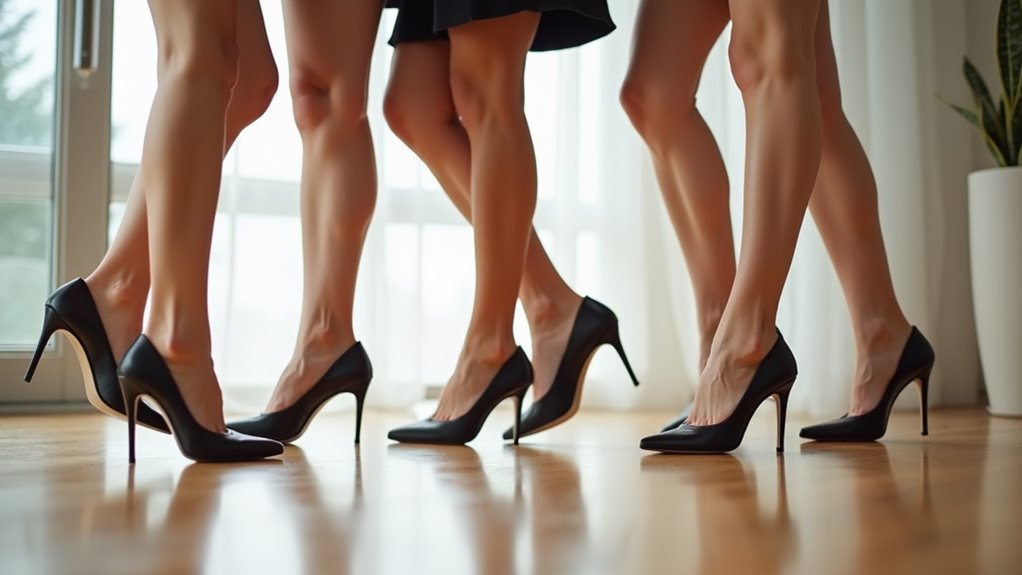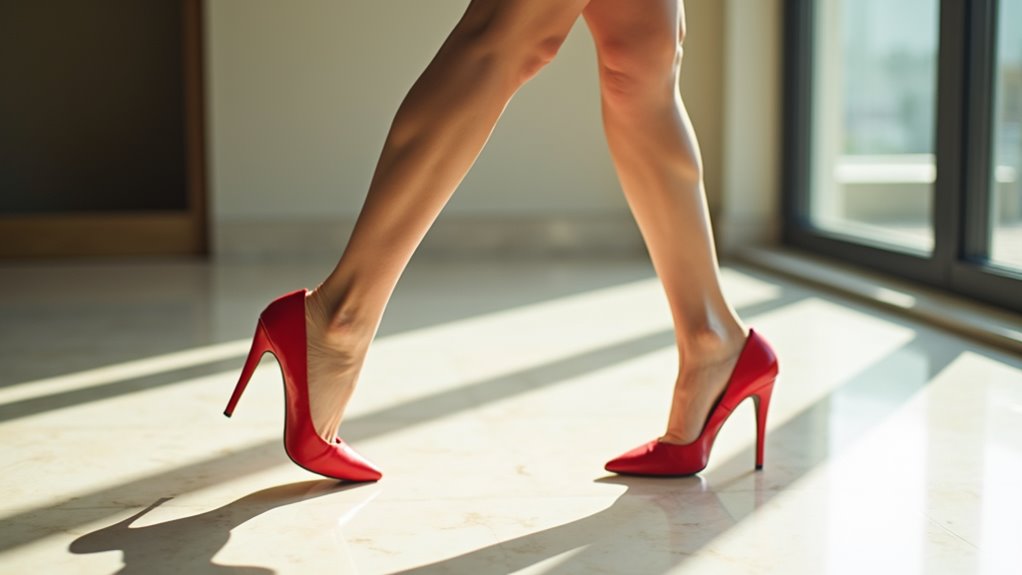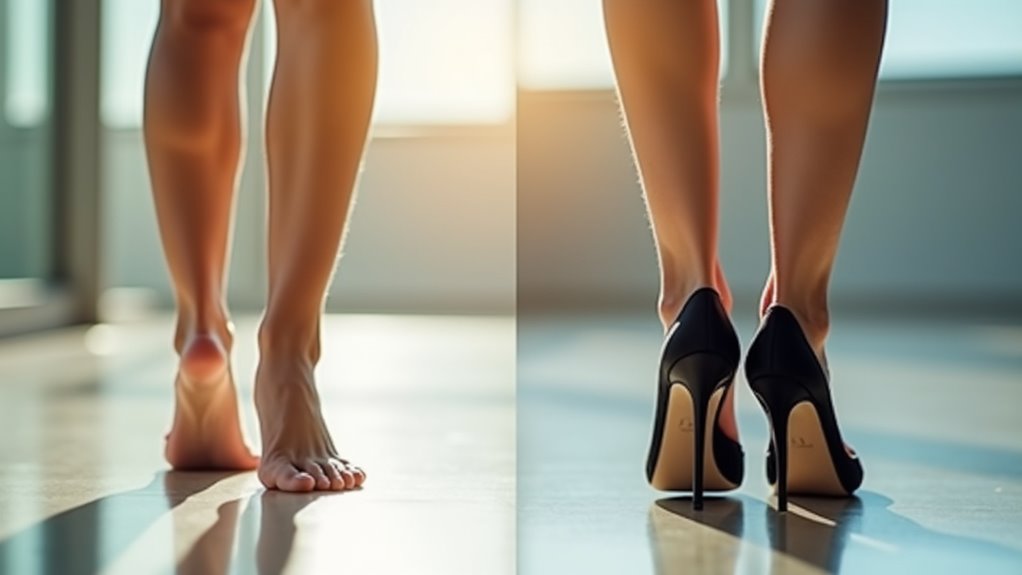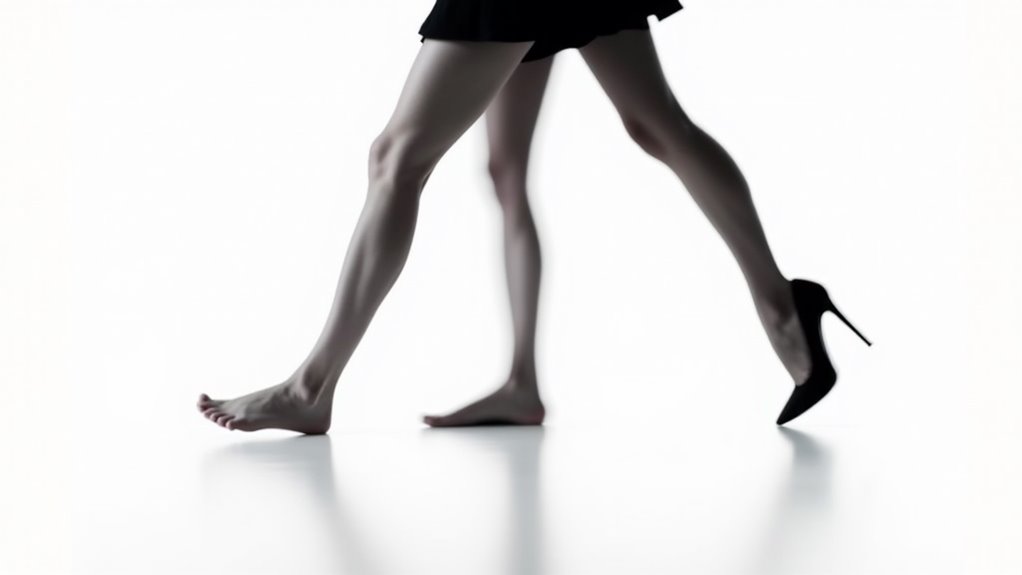There may be products. Products are independently selected by our editors. We may earn an affiliate commission from the links with no charge to you, example: as Amazon Affiliate.
Did you know that women who wear high heels regularly are 10 times more likely to experience foot and ankle injuries compared to those who don’t? If you’re among the millions who sacrifice comfort for style, you’ve probably noticed changes in how you walk while wearing your favorite heels. What you might not realize is that these altered walking patterns can affect everything from your toes to your lower back, creating a chain reaction of biomechanical adjustments throughout your body. Understanding these changes isn’t just about preventing discomfort – it’s about protecting your long-term joint and muscle health.
Key Takeaways
- High heels shorten stride length and reduce walking speed by up to 65%, significantly altering natural gait patterns.
- Weight distribution shifts forward, forcing increased knee flexion and pelvic tilt while reducing ankle mobility.
- The stance phase becomes unstable with altered muscle activation, increasing risk of ankle injuries and falls.
- Double support time increases as balance becomes compromised, making smooth transitions between steps more difficult.
- Regular high heel wear can lead to shortened Achilles tendons and altered walking patterns even when barefoot.
Understanding Basic Gait Mechanics

Walking is a complex symphony of coordinated movements that follows a predictable cycle. Your gait cycle consists of two main phases: the stance phase, when your foot contacts the ground for 60% of the cycle, and the swing phase, which takes up the remaining 40% as your foot moves through the air.
During initial contact, your ankle maintains a neutral position while your knee flexes slightly at 5 degrees, and your hip flexes at 30 degrees. Your muscles work together throughout these phases – your dorsiflexors, quadriceps, and hip muscles coordinate to control movement and maintain stability.
You’ll experience periods of double support, where both feet contact the ground for about 20% of your walking cycle, ensuring smooth transitions between steps.
High Heels Change Body Position
When you slip on a pair of high heels, your body immediately shifts into a series of compensatory positions. Your pelvis tilts forward, creating an unnatural alignment of your spine and increasing lordosis. This change forces your back muscles to work harder, often leading to tension and strain. The effects cascade up through your body, potentially causing neck pain and headaches.
| Body Part | Position Change | Impact |
|---|---|---|
| Pelvis | Forward Tilt | Increased Strain |
| Spine | Enhanced Lordosis | Back Pain |
| Muscles | Overactivation | Fatigue |
| Neck | Forward Shift | Headaches |
| Center of Gravity | Upward & Forward | Balance Issues |
Your body’s natural alignment becomes compromised as your center of gravity shifts, forcing your knees and ankles into increased flexion. These changes aren’t just temporary – they can lead to long-term musculoskeletal issues, especially with regular wear.
Common Walking Pattern Alterations

When you walk in high heels, you’ll notice your steps become significantly shorter as your feet adjust to the altered mechanics and restricted movement.
Your body’s natural balance becomes compromised due to the elevation of your heel and the shift in weight distribution toward your forefoot.
You’ll find yourself compensating for these changes by adjusting your posture and gait, which can lead to uneven pressure across your feet.
Shortened Strides, Less Balance
Although high heels remain a popular fashion choice, they significantly alter your natural walking patterns by forcing shorter strides and compromising balance. When you wear high heels, your feet are forced into an increased plantar flexion position, causing you to take smaller steps and walk up to 65% slower than normal.
You’ll notice your stability decreases as high heels create muscle imbalances and restrict your ankle’s natural movement. The elevated heel position increases knee flexion and changes your pelvic tilt, putting extra stress on your knees and lower back.
Your body compensates by adjusting its posture, but this often leads to poor balance and a higher risk of stumbling or twisting an ankle. These changes can result in long-term muscle adaptations, with some muscles becoming shortened while others weaken.
Uneven Weight Distribution Forward
High heels dramatically shift your body’s natural weight distribution, forcing up to 90% of your foot pressure onto the balls of your feet and toe joints.
This forward-leaning position creates excessive stress on your forefoot while reducing the weight-bearing function of your heel, disrupting your normal walking pattern.
When you’re wearing heels, you’ll notice your body compensating for this uneven distribution.
Your ankles tilt forward, your knees flex more, and your lower back curves to maintain balance.
This altered weight placement affects both your standing posture and walking mechanics, potentially leading to conditions like bunions, hammertoes, and plantar fasciitis.
You can minimize these effects by choosing thicker heels, using metatarsal pads, and limiting the time you spend in high heels.
Physical Effects on Joints
Wearing high heels triggers three major changes in joint alignment throughout your body.
First, your ankles roll inward, straining tendons and ligaments while forcing your feet into an unnatural plantar flexion position.
Second, your knees and hips experience increased stress due to altered walking mechanics, leading to greater bone-on-bone forces in your knee joints.
Third, your spine curves more dramatically, resulting in increased lumbar lordosis and potential lower back pain.
These alignment changes don’t just affect how you walk – they’re causing long-term damage to your joints.
Your cartilage wears down faster under the increased pressure, and your muscles adapt to these altered positions.
Over time, you’re at higher risk for developing osteoarthritis, particularly in your knees and hips, while your spine may face accelerated degeneration.
Fortunately, modern comfort-focused heels can help minimize these joint alignment issues while maintaining style.
Preventive Steps for Heel Wearers

You’ll find greater comfort and stability by choosing heels no higher than three inches and opting for thicker heel styles that distribute weight more evenly.
It’s essential to rotate between different types of shoes throughout the week, avoiding daily wear of high heels and switching to comfortable alternatives when possible.
You can protect your feet and ankles by incorporating daily stretching and strengthening exercises, focusing particularly on your calf muscles and core stability.
Consider investing in classic black leather heels for their timeless versatility and enduring style appeal.
Smart Heel Height Selection
When selecting the right heel height, several crucial factors must be considered to prevent discomfort and potential injury. Your leg length, foot size, and natural posture play vital roles in determining the most suitable height.
If you have smaller feet, you’ll need to be especially mindful as heels may feel steeper.
For everyday wear, stick to low heels of 1-2 inches, which offer the best balance between style and functionality. Save your 3-4 inch heels for formal events where you won’t be standing for extended periods.
When measuring heel height, use a ruler from the base to where it meets the shoe. Remember that your ankle strength matters too – if you have weak ankles, opt for lower heels to minimize your risk of injury.
Rotation Between Shoe Types
Regular rotation between different shoe types serves as a crucial preventive measure for high heel wearers.
By alternating between different heel heights, you’ll reduce strain on your Achilles tendon and prevent chronic shortening that can lead to pain.
When rotating shoes, focus on varying designs that support foot health.
Choose open-toe styles to alleviate pressure on corns and calluses, and opt for chunky heels that provide better stability.
You’ll want to include shoes with wider toe boxes and square-toe designs in your rotation to prevent foot deformities.
Remember to limit high heel wear to less than three hours daily and incorporate lower-heeled options to decrease pressure on the ball of your foot.
This mindful rotation helps maintain normal foot mechanics while reducing your risk of musculoskeletal pain and ankle injuries.
Exercise For Foot Strength
Strengthening your feet through targeted exercises helps counteract the negative effects of wearing high heels. You’ll want to focus on exercises that target your toes, ankles, and calves to maintain proper foot function and prevent injury.
| Exercise Type | Benefit | Technique |
|---|---|---|
| Toe Raises | Strengthens foot muscles | Lift heels while keeping toes down |
| Ankle Circles | Improves mobility | Draw circles with lifted foot |
| Calf Stretches | Prevents tendinitis | Rise up/down on step edge |
Don’t forget to include toe tapping exercises, which boost circulation and flexibility. Perform three sets of 10 repetitions while seated with your feet flat on the floor. These exercises become especially important if you wear heels regularly, as they help combat altered muscle activation and increased joint loading that occurs with high heel use.
Long Term Health Considerations
Although high heels remain a popular fashion choice, their long-term impact on your body’s health can be severe and far-reaching.
You’ll face an increased risk of developing osteoarthritis, particularly in your feet and knees, due to the altered weight distribution and joint stress. Your Achilles tendon may shorten and stiffen over time, while your lower back could suffer from increased lordosis and instability.
The prolonged wear of high heels can lead to chronic foot conditions like bunions, hammertoes, and Morton’s Neuroma.
You’re also more likely to experience persistent muscle fatigue in your legs and back. To protect your long-term health, you’ll want to limit how often you wear heels, opt for thicker heel styles when possible, and maintain regular visits to a podiatrist for preventive care.
Conclusion
Like a tightrope walker on a precarious wire, you’re gambling with your body’s natural balance when you strap on those sky-high heels. While they’ll make you feel like you’re walking on clouds, your joints are crying out like rusty hinges. Don’t let fashion become your downfall – take steps to protect your feet, or you’ll pay the price with every stiletto-shaped stride.

